Edelstein-Keshet L. Mathematical Models in Biology
Подождите немного. Документ загружается.

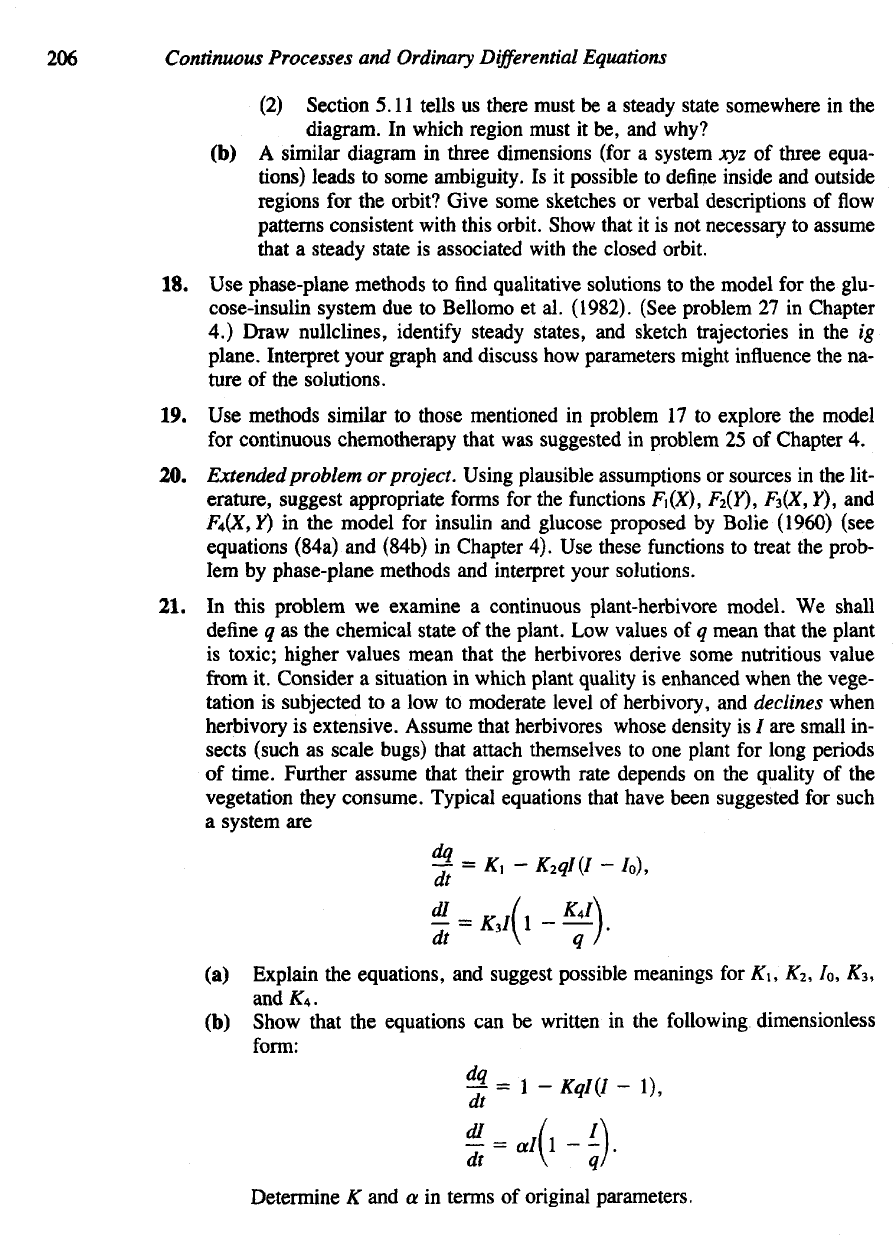
206
Continuous Processes
and
Ordinary
Differential
Equations
(2)
Section 5.11 tells
us
there must
be a
steady state somewhere
in the
diagram.
In
which region must
it be, and
why?
(b) A
similar diagram
in
three dimensions (for
a
system
xyz of
three equa-
tions) leads
to
some ambiguity.
Is it
possible
to
define
inside
and
outside
regions
for the
orbit? Give some sketches
or
verbal
descriptions
of flow
patterns consistent with
this
orbit. Show that
it is not
necessary
to
assume
that
a
steady state
is
associated
with
the
closed orbit.
18. Use
phase-plane
methods
to find
qualitative solutions
to the
model
for the
glu-
cose-insulin system
due to
Bellomo
et al.
(1982). (See problem
27 in
Chapter
4.)
Draw nullclines,
identify
steady states,
and
sketch trajectories
in the ig
plane.
Interpret
your graph
and
discuss
how
parameters might influence
the na-
ture
of the
solutions.
19. Use
methods similar
to
those mentioned
in
problem
17 to
explore
the
model
for
continuous chemotherapy that
was
suggested
in
problem
25 of
Chapter
4.
20.
Extended
problem
or
project. Using plausible assumptions
or
sources
in the
lit-
erature, suggest appropriate forms
for the
functions
F\(X), F
2
(Y), F$(X,
Y), and
F
4
(X,
Y)
in the
model
for
insulin
and
glucose
proposed
by
Bolie
(1960)
(see
equations (84a)
and
(84b)
in
Chapter
4). Use
these
functions
to
treat
the
prob-
lem by
phase-plane methods
and
interpret your solutions.
21. In
this problem
we
examine
a
continuous plant-herbivore model.
We
shall
define
q as the
chemical state
of the
plant.
Low
values
of q
mean that
the
plant
is
toxic; higher values mean that
the
herbivores derive some nutritious value
from it.
Consider
a
situation
in
which plant quality
is
enhanced when
the
vege-
tation
is
subjected
to a low to
moderate level
of
herbivory,
and
declines when
herbivory
is
extensive. Assume that herbivores whose density
is / are
small
in-
sects (such
as
scale
bugs) that attach themselves
to one
plant
for
long periods
of
time. Further assume that their growth rate depends
on the
quality
of the
vegetation they consume. Typical equations that have been suggested
for
such
a
system
are
(a)
Explain
the
equations,
and
suggest possible meanings
for K\,
AT
2
,
7
0
,
AT
3
,
and
K*,.
(b)
Show that
the
equations
can be
written
in the
following dimensionless
form:
Determine
K and a in
terms
of
original parameters.
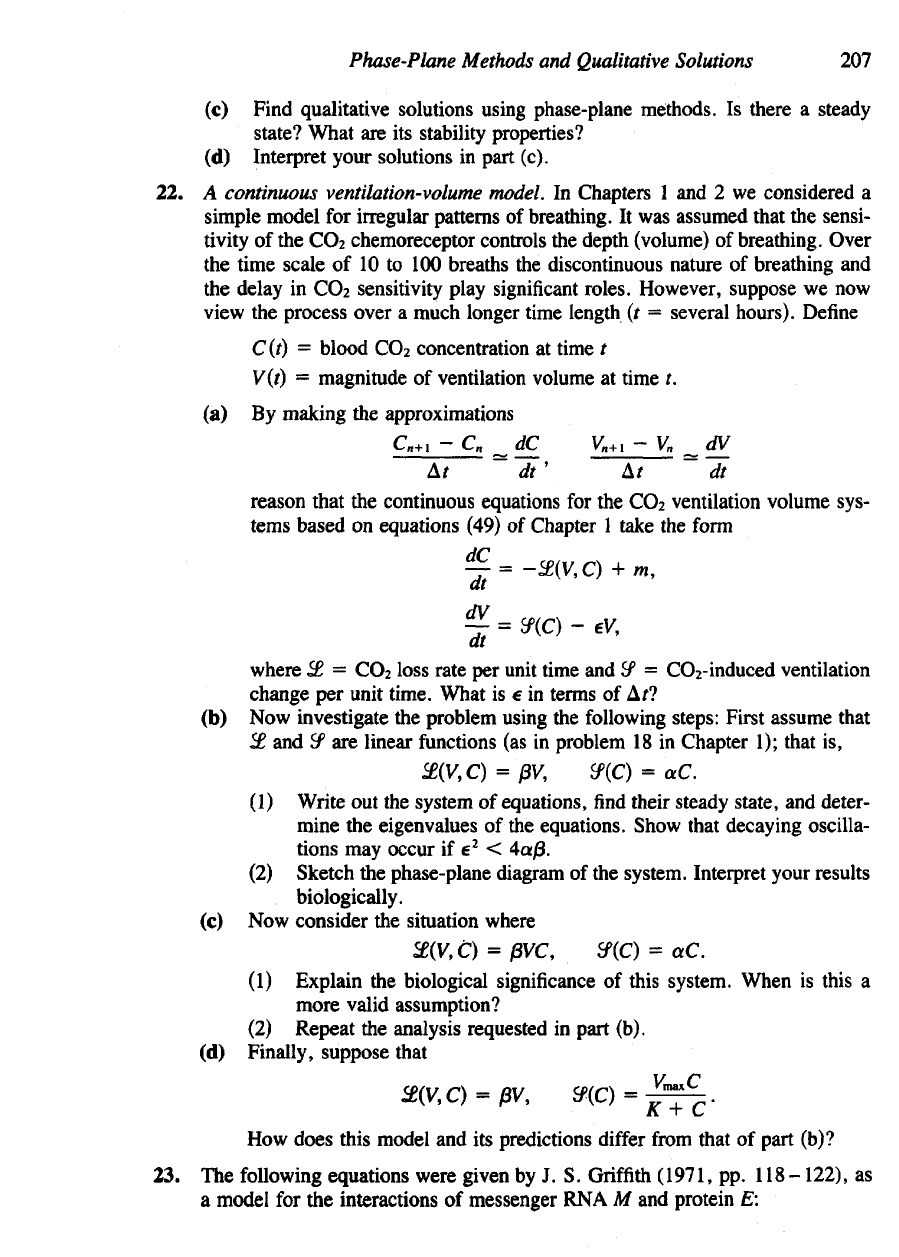
Phase-Plane
Methods
and
Qualitative Solutions
207
(c)
Find qualitative solutions using phase-plane methods.
Is
there
a
steady
state?
What
are its
stability properties?
(d)
Interpret your solutions
in
part (c).
22. A
continuous ventilation-volume model.
In
Chapters
1 and 2 we
considered
a
simple model
for
irregular patterns
of
breathing.
It was
assumed that
the
sensi-
tivity
of the CO2
chemoreceptor controls
the
depth (volume)
of
breathing. Over
the
time
scale
of 10 to 100
breaths
the
discontinuous nature
of
breathing
and
the
delay
in
CC>2
sensitivity play
significant
roles. However, suppose
we now
view
the
process over
a
much longer time length
(t =
several hours).
Define
C(t)
=
blood
CO
2
concentration
at
time
t
V(t)
=
magnitude
of
ventilation volume
at
time
t.
(a) By
making
the
approximations
reason that
the
continuous equations
for the CO
2
ventilation volume sys-
tems
based
on
equations (49)
of
Chapter
1
take
the
form
where
SB
= COa
loss rate
per
unit
time
and tf =
CO
2
-
induced
ventilation
change
per
unit time. What
is € in
terms
of Af?
(b) Now
investigate
the
problem using
the
following steps: First assume that
SB
and V are
linear functions
(as in
problem
18 in
Chapter
1);
that
is,
(1)
Write
out the
system
of
equations,
find
their steady state,
and
deter-
mine
the
eigenvalues
of the
equations. Show that decaying oscilla-
tions
may
occur
if e
2
<
4a/3.
(2)
Sketch
the
phase-plane diagram
of the
system. Interpret your results
biologically.
(c) Now
consider
the
situation where
(1)
Explain
the
biological significance
of
this system. When
is
this
a
more valid assumption?
(2)
Repeat
the
analysis requested
in
part (b).
(d)
Finally, suppose that
How
does
this model
and its
predictions
differ
from
that
of
part (b)?
23. The
following equations were given
by J. S.
Griffith
(1971,
pp.
118-122),
as
a
model
for the
interactions
of
messenger
RNA M and
protein
E:
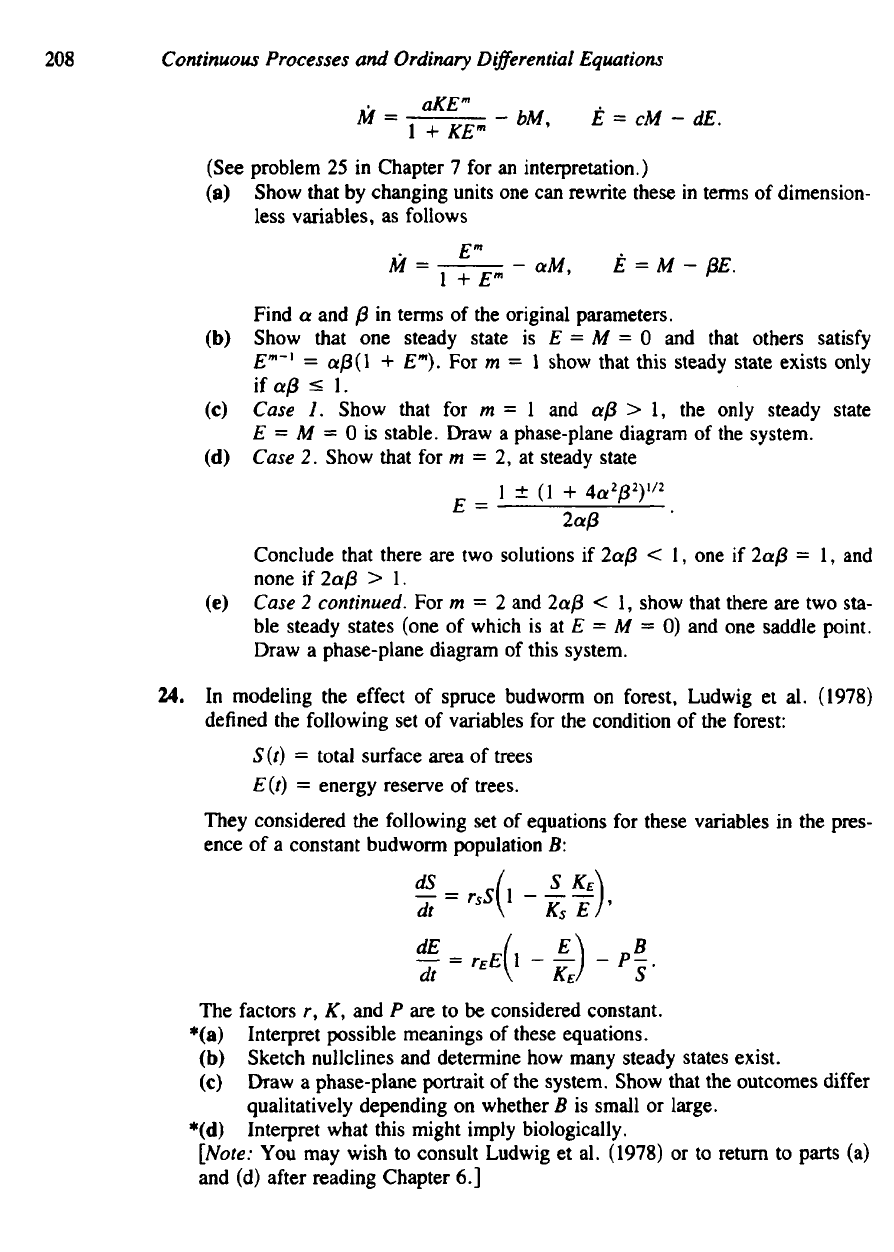
208
Continuous Processes
and
Ordinary
Differential
Equations
(See problem
25 in
Chapter
7 for an
interpretation.)
(a)
Show that
by
changing
units
one can
rewrite these
in
terms
of
dimension-
less
variables,
as
follows
Find
a and /8 in
terms
of the
original parameters.
(b)
Show that
one
steady state
is E = M = 0 and
that
others
satisfy
E
m
~
l
=
aj8(l
+
E
m
).
For m - 1
show that this steady
state
exists
only
if
ajS < 1.
(c)
Case
1.
Show that
for m - 1 and a(3 > 1, the
only steady state
E
= M = 0 is
stable. Draw
a
phase-plane diagram
of the
system.
(d)
Case
2.
Show that
for m = 2, at
steady state
Conclude that there
are two
solutions
if
2aj3
< 1, one if
2a(3
= 1, and
none
if
2a(3
> 1.
(e)
Case
2
continued.
For m = 2 and
2a/3
< 1,
show that there
are two
sta-
ble
steady states (one
of
which
is at E = M = 0) and one
saddle point.
Draw
a
phase-plane diagram
of
this system.
24. In
modeling
the
effect
of
spruce budworm
on
forest, Ludwig
et al.
(1978)
defined
the
following
set of
variables
for the
condition
of the
forest:
S(t)
=
total surface area
of
trees
E(t)
=
energy reserve
of
trees.
They considered
the
following
set of
equations
for
these variables
in the
pres-
ence
of a
constant budworm population
B:
The
factors
r, K, and P are to be
considered constant,
''(a) Interpret
possible
meanings
of
these equations.
(b)
Sketch nullclines
and
determine
how
many steady states exist.
(c)
Draw
a
phase-plane
portrait
of the
system. Show that
the
outcomes
differ
qualitatively
depending
on
whether
B is
small
or
large.
"(d)
Interpret what this might imply biologically.
[Note:
You may
wish
to
consult Ludwig
et al.
(1978)
or to
return
to
parts
(a)
and
(d)
after
reading Chapter
6.]
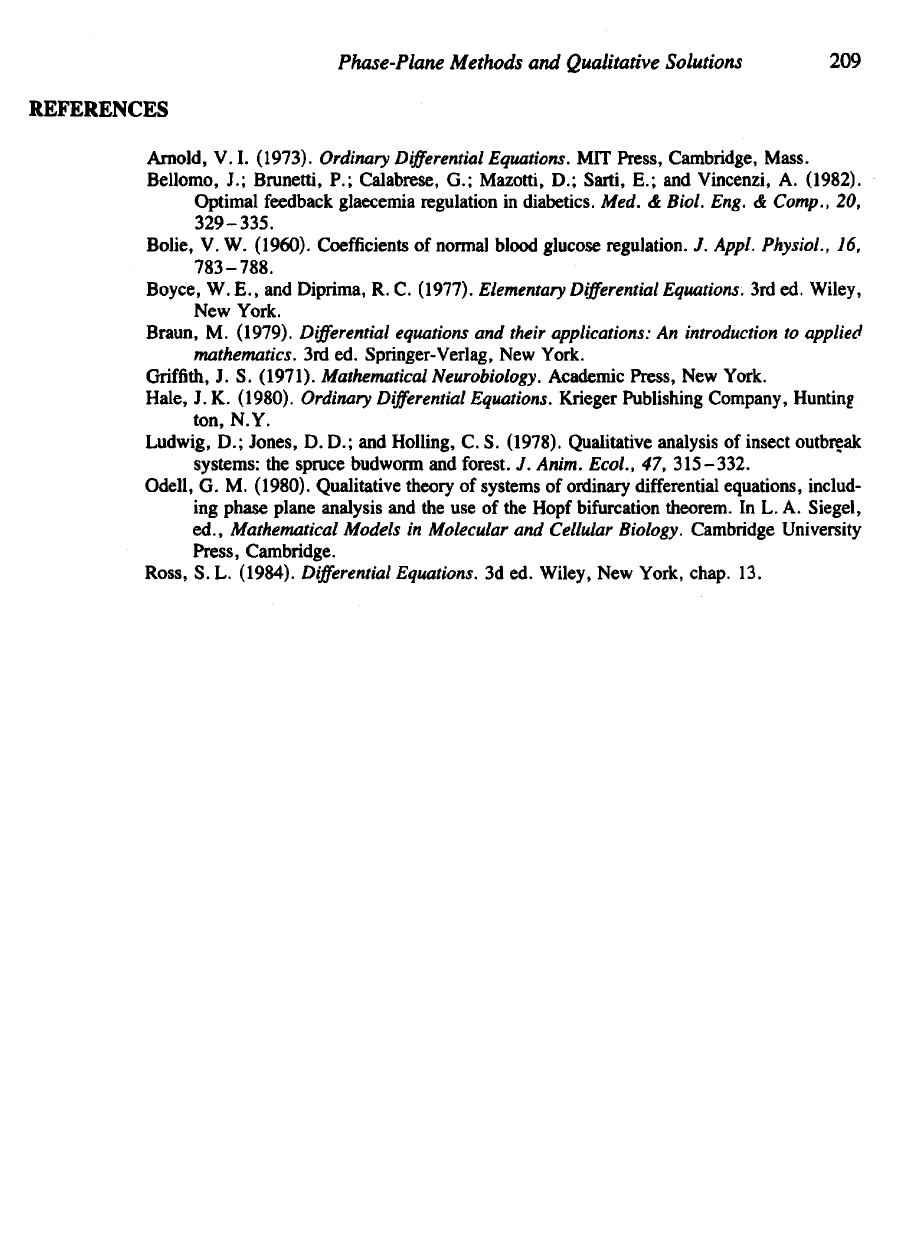
Phase-Plane
Methods
and
Qualitative Solutions
209
REFERENCES
Arnold,
V. I.
(1973).
Ordinary
Differential
Equations.
MIT
Press,
Cambridge, Mass.
Bellomo,
J.;
Brunetti,
P.;
Calabrese,
G.;
Mazotti,
D.;
Sarti,
E.; and
Vincenzi,
A.
(1982).
Optimal feedback glaecemia regulation
in
diabetics. Med.
&
Biol.
Eng.
&
Comp.,
20,
329-335.
Bolie,
V. W.
(1960).
Coefficients
of
normal blood
glucose
regulation.
J.
Appl. Physiol.,
16,
783-788.
Boyce,
W. E., and
Diprima,
R. C.
(1977).
Elementary
Differential
Equations.
3rd ed.
Wiley,
New
York.
Braun,
M.
(1979).
Differential
equations
and
their
applications:
An
introduction
to
applied
mathematics.
3rd ed.
Springer-Verlag,
New
York.
Griffith,
J. S.
(1971).
Mathematical
Neurobiology. Academic Press,
New
York.
Hale,
J. K.
(1980).
Ordinary
Differential
Equations. Krieger Publishing Company,
Hunting
ton,
N.Y.
Ludwig,
D.;
Jones,
D. D.; and
Holling,
C. S.
(1978). Qualitative analysis
of
insect outbreak
systems:
the
spruce budworm
and
forest.
J.
Anim. EcoL,
47,
315-332.
Odell,
G. M.
(1980).
Qualitative theory
of
systems
of
ordinary differential equations, includ-
ing
phase
plane analysis
and the use of the
Hopf bifurcation theorem.
In L. A.
Siegel,
ed., Mathematical
Models
in
Molecular
and
Cellular Biology. Cambridge University
Press,
Cambridge.
Ross,
S. L.
(1984).
Differential
Equations.
3d ed.
Wiley,
New
York, chap.
13.
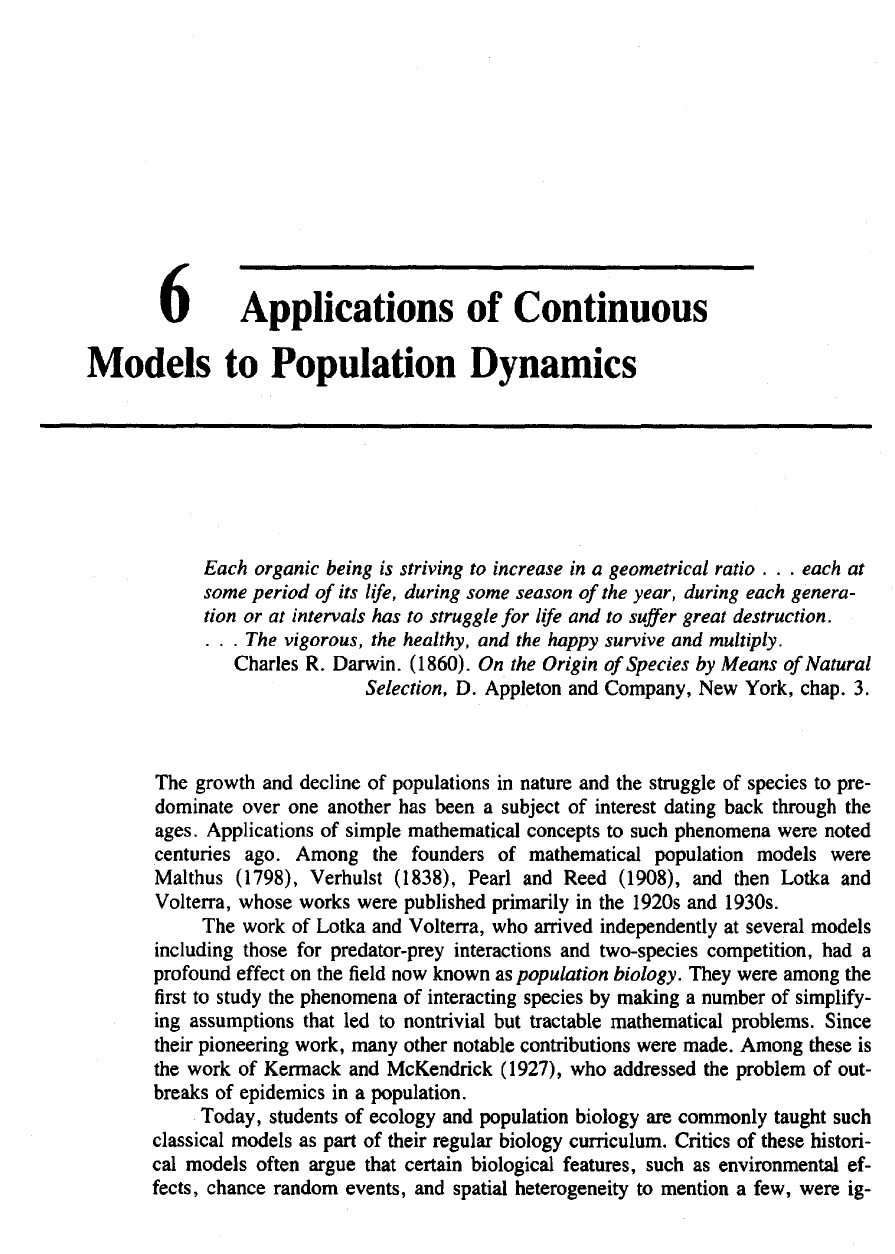
0
Applications
of
Continu s
Models
to
Population
Dynamics
Each organic being
is
striving
to
increase
in a
geometrical ratio
. . .
each
at
some period
of its
life,
during some season
of the
year,
during
each genera-
tion
or at
intervals
has to
struggle
for
life
and to
suffer
great destruction.
. . . The
vigorous,
the
healthy,
and the
happy
survive
and
multiply.
Charles
R.
Darwin. (1860).
On the
Origin
of
Species
by
Means
of
Natural
Selection,
D.
Appleton
and
Company,
New
York, chap.
3.
The
growth
and
decline
of
populations
in
nature
and the
struggle
of
species
to
pre-
dominate
over
one
another
has
been
a
subject
of
interest dating back through
the
ages. Applications
of
simple mathematical concepts
to
such phenomena were noted
centuries ago. Among
the
founders
of
mathematical population models were
Malthus
(1798),
Verhulst
(1838),
Pearl
and
Reed
(1908),
and
then Lotka
and
Volterra, whose works were published primarily
in the
1920s
and
1930s.
The
work
of
Lotka
and
Volterra,
who
arrived independently
at
several models
including
those
for
predator-prey interactions
and
two-species competition,
had a
profound
effect
on the field now
known
as
population biology. They were among
the
first to
study
the
phenomena
of
interacting species
by
making
a
number
of
simplify-
ing
assumptions that
led to
nontrivial
but
tractable mathematical problems. Since
their pioneering work, many other notable contributions were made. Among these
is
the
work
of
Kermack
and
McKendrick (1927),
who
addressed
the
problem
of
out-
breaks
of
epidemics
in a
population.
Today, students
of
ecology
and
population biolo
are
commonly taught such
classical models
as
part
of
their regular biology curriculum. Critics
of
these histori-
cal
models often argue that certain biological features, such
as
environmental
ef-
fects,
chance random events,
and
spatial heterogeneity
to
mention
a
few, were
ig-
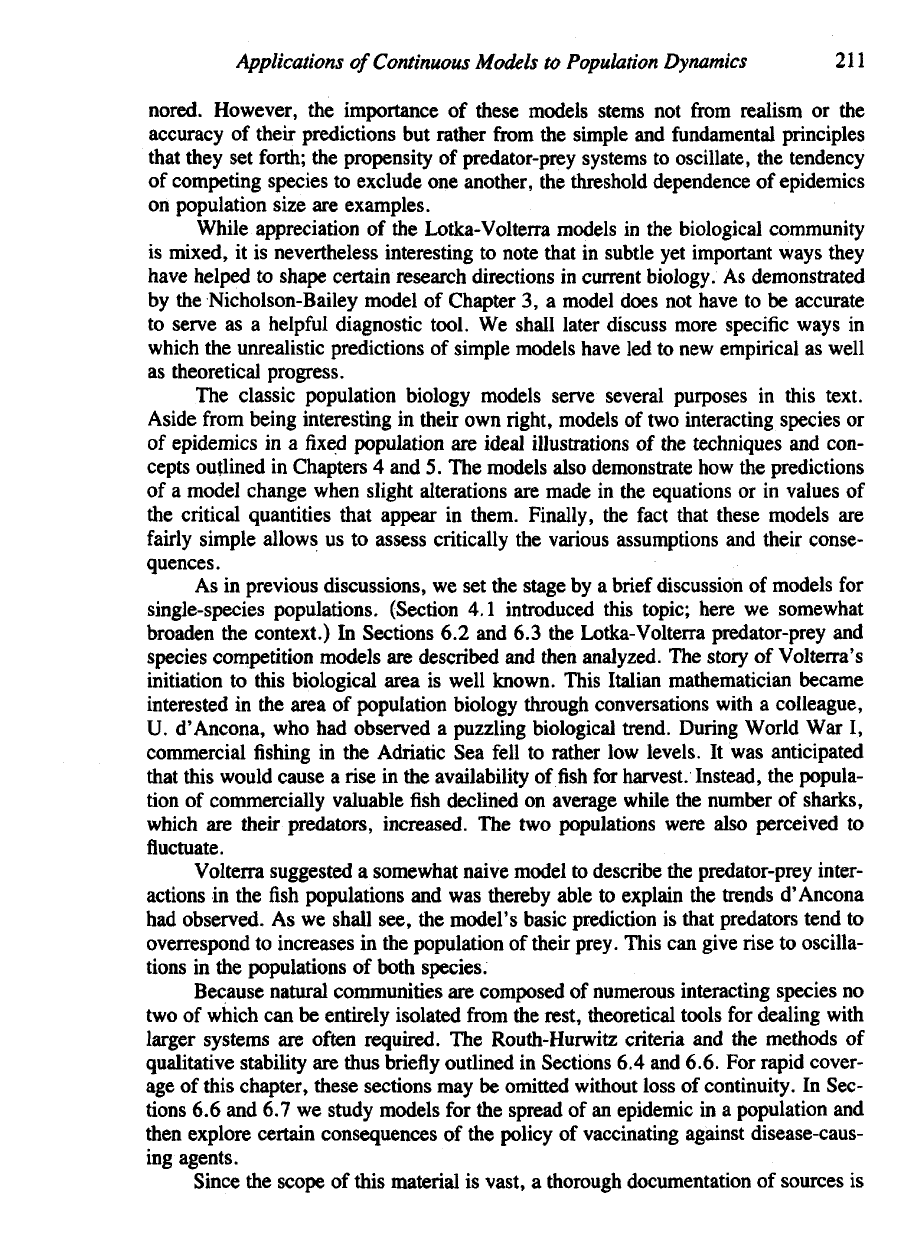
Applications
of
Continuous
Models
to
Populat n
Dynamics
211
nored. However,
the
importance
of
these models stems
not
from
realism
or the
accuracy
of
their predictions
but
rather
from
the
simple
and
fundamental
principles
that
they
set
forth;
the
propensity
of
predator-prey systems
to
oscillate,
the
tendency
of
competing species
to
exclude
one
another,
the
threshold dependence
of
epidemics
on
population size
are
examples.
While appreciation
of the
Lotka-Volterra models
in the
biological community
is
mixed,
it is
nevertheless interesting
to
note that
in
subtle
yet
important ways they
have helped
to
shape certain research directions
in
current biology.
As
demonstrated
by
the
Nicholson-Bailey model
of
Chapter
3, a
model does
not
have
to be
accurate
to
serve
as a
helpful
diagnostic tool.
We
shall later discuss more
specific
ways
in
which
the
unrealistic predictions
of
simple models have
led to new
empirical
as
well
as
theoretical progress.
The
classic population biology models serve several purposes
in
this text.
Aside
from
being interesting
in
their
own right,
models
of two
interacting species
or
of
epidemics
in a fixed
population
are
ideal illustrations
of the
techniques
and
con-
cepts outlined
in
Chapters
4 and 5. The
models also demonstrate
how the
predictions
of
a
model change when slight alterations
are
made
in the
equations
or in
values
of
the
critical quantities that appear
in
them. Finally,
the
fact
that these models
are
fairly
simple allows
us to
assess critically
the
various assumptions
and
their conse-
quences.
As
in
previous discussions,
we set the
stage
by a
brief discussion
of
models
for
single-species
populations. (Section
4.1
introduced this
topic;
here
we
somewhat
broaden
the
context.)
In
Sections
6.2 and 6.3 the
Lotka-Volterra predator-prey
and
species
competition models
are
described
and
then analyzed.
The
story
of
Volterra's
initiation
to
this biological area
is
well known. This Italian mathematician became
interested
in the
area
of
population biology through conversations with
a
colleague,
U.
d'Ancona,
who had
observed
a
puzzling biological trend. During World
War I,
commercial
fishing in the
Adriatic
Sea
fell
to
rather
low
levels.
It was
anticipated
that
this would cause
a rise in the
availability
of fish for
harvest. Instead,
the
popula-
tion
of
commercially valuable
fish
declined
on
average while
the
number
of
sharks,
which
are
their
predators,
increased.
The two
populations were
also
perceived
to
fluctuate.
Volterra suggested
a
somewhat naive model
to
describe
the
predator-prey inter-
actions
in the fish
populations
and was
thereby able
to
explain
the
trends d'Ancona
had
observed.
As we
shall see,
the
model's basic prediction
is
that predators tend
to
overrespond
to
increases
in the
population
of
their prey. This
can
give
rise to
oscilla-
tions
in the
populations
of
both
species.
Because natural communities
are
composed
of
numerous interacting
species
no
two
of
which
can be
entirely isolated
from
the
rest,
theoretical
tools
for
dealing with
larger systems
are
often required.
The
Routh-Hurwitz criteria
and the
methods
of
qualitative stability
are
thus
briefly
outlined
in
Sections
6.4 and
6.6.
For
rapid cover-
age of
this chapter, these sections
may be
omitted without loss
of
continuity.
In
Sec-
tions
6.6 and 6.7 we
study models
for the
spread
of an
epidemic
in a
population
and
then
explore certain consequences
of the
policy
of
vaccinating against disease-caus-
ing
agents.
Since
the
scope
of
this material
is
vast,
a
thorough documentation
of
sources
is
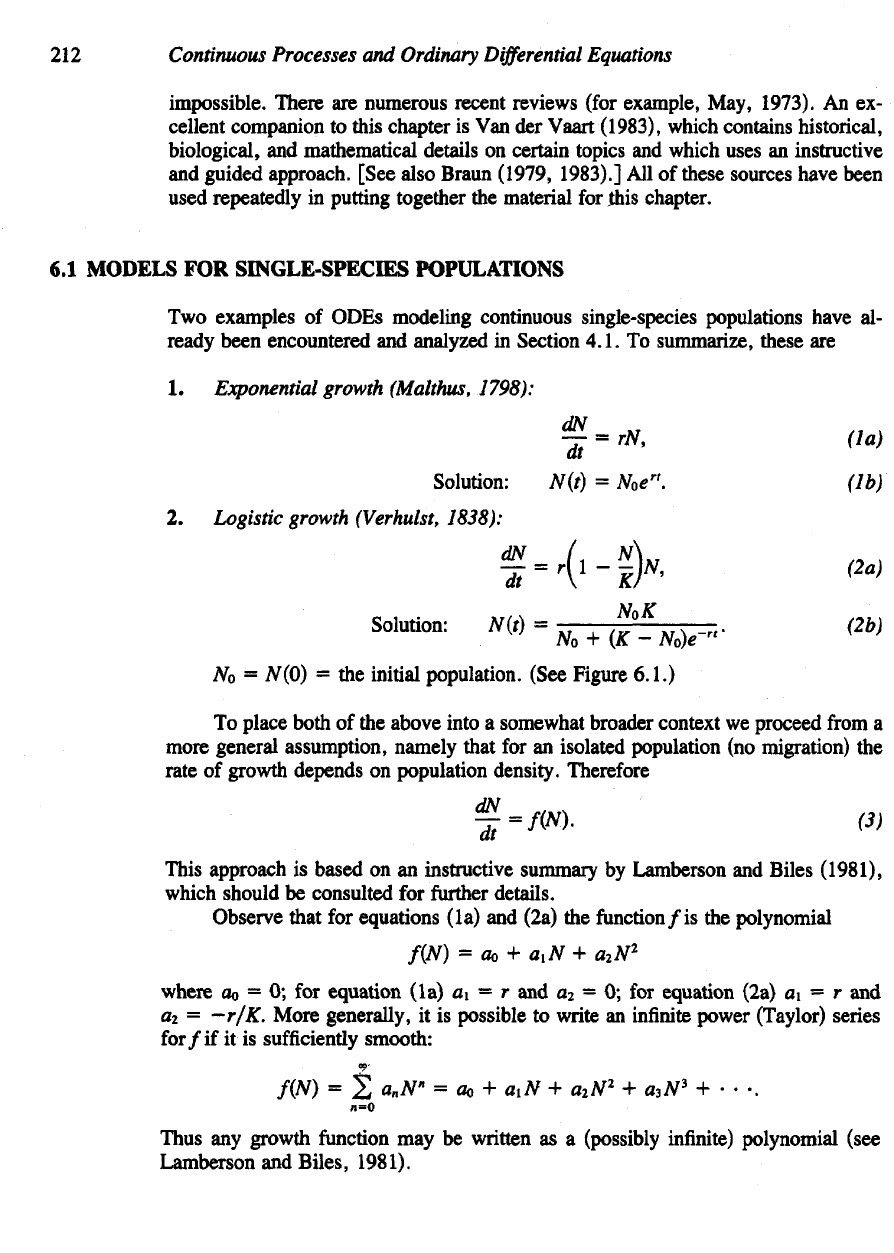
212
Continuous Processes
and
Ordinary
Differential
Equations
impossible.
There
ar
numerous recent reviews (for example, May, 1973).
An ex-
cellent companion
to
this chapter
is Van der
Vaart (1983), which contains historical,
biological,
and
mathematical details
on
certain topics
and
which uses
an
instructive
and
guided approach. [See also Braun (1979,
1983).]
All of
these sources have been
used repeatedly
in
putting together
e
material
for
Jhis chapter.
6.1
MODELS
FOR
SINGLE-SPECIES
POPULATIONS
Two
examples
of
ODEs modeling continuous single-species populations have
al-
ready been encountered
and
analyzed
in
Section 4.1.
To
summarize, these
are
1.
Exponential
growth
(Malthus,
1798):
2.
Logistic growth
(Verhulst,
1838):
No
=
N(0)
= the
initial population. (See Figure 6.1.)
To
place both
of the
above into
a
somewhat broader context
we
proceed
from
a
more general assumption, namely that
for an
isolated population
(no
migration)
the
rate
of
growth depend
n
population density. Therefore
This
approach
is
based
on an
instructive summary
by
Lamberson
and
Biles (1981),
which
should
be
consulted
for
further
details.
Observe that
for
equations (la)
and
(2a)
the
function/is
the
polynomial
where
OQ
= 0; for
equation (la)
a\ = r and #2 = 0; for
equation (2a)
a\ = r and
a-i
-
-r/K. More generally,
it is
possible
to
write
an
infinite
power (Taylor) series
for/if
it is
sufficiently
smooth:
Thus
any
growth
function
may be
written
as a
(possibly
infinite)
polynomial (see
Lamberson
and
Biles, 1981).
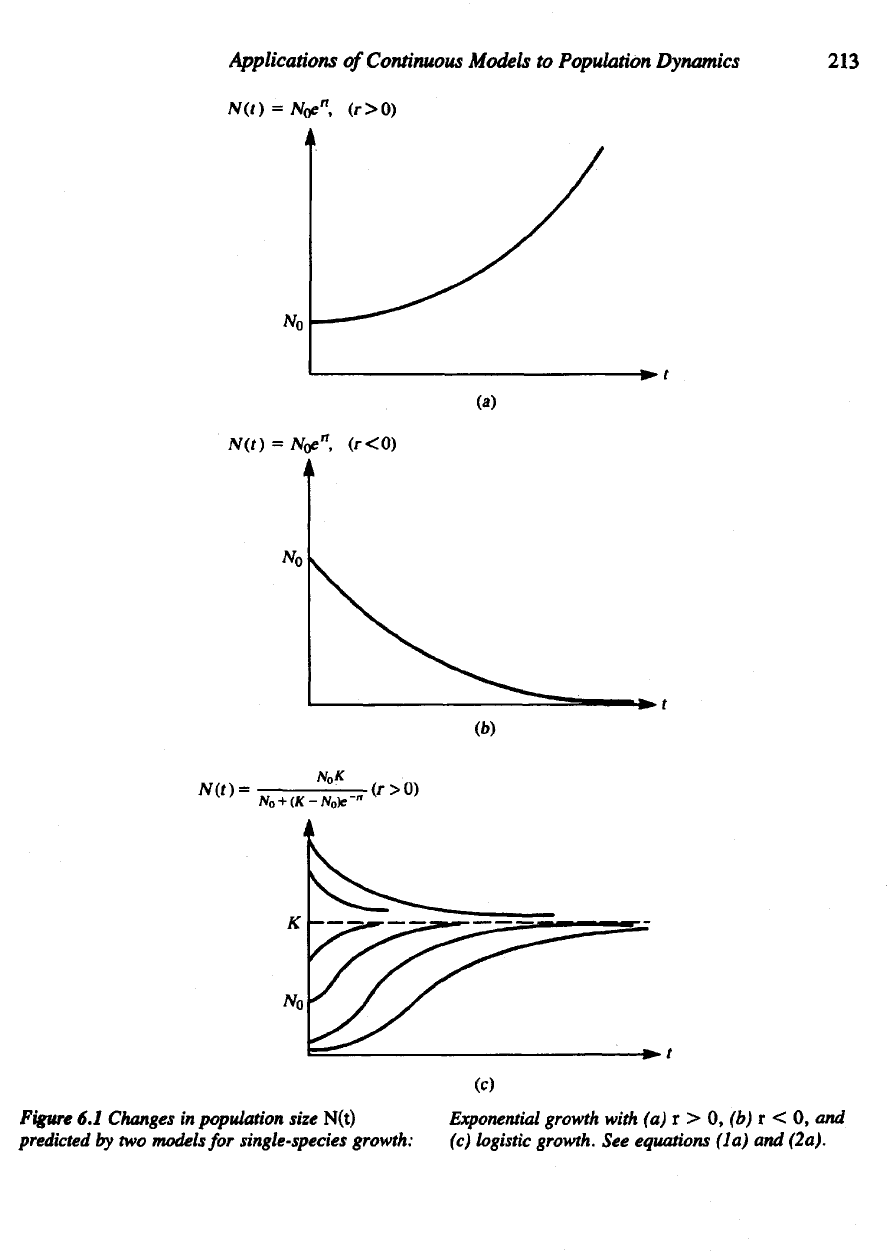
Exponential
growth with
(a) r > 0, (b) r < 0, and
(c)
logistic growth.
See
equations (la)
and
(2a).
Figure
6.1
Changes
in
population size N(t)
predicted
by two
models
for
single-species growth:
Applications
of
Continuous
Models
to
Population
Dynamics
213
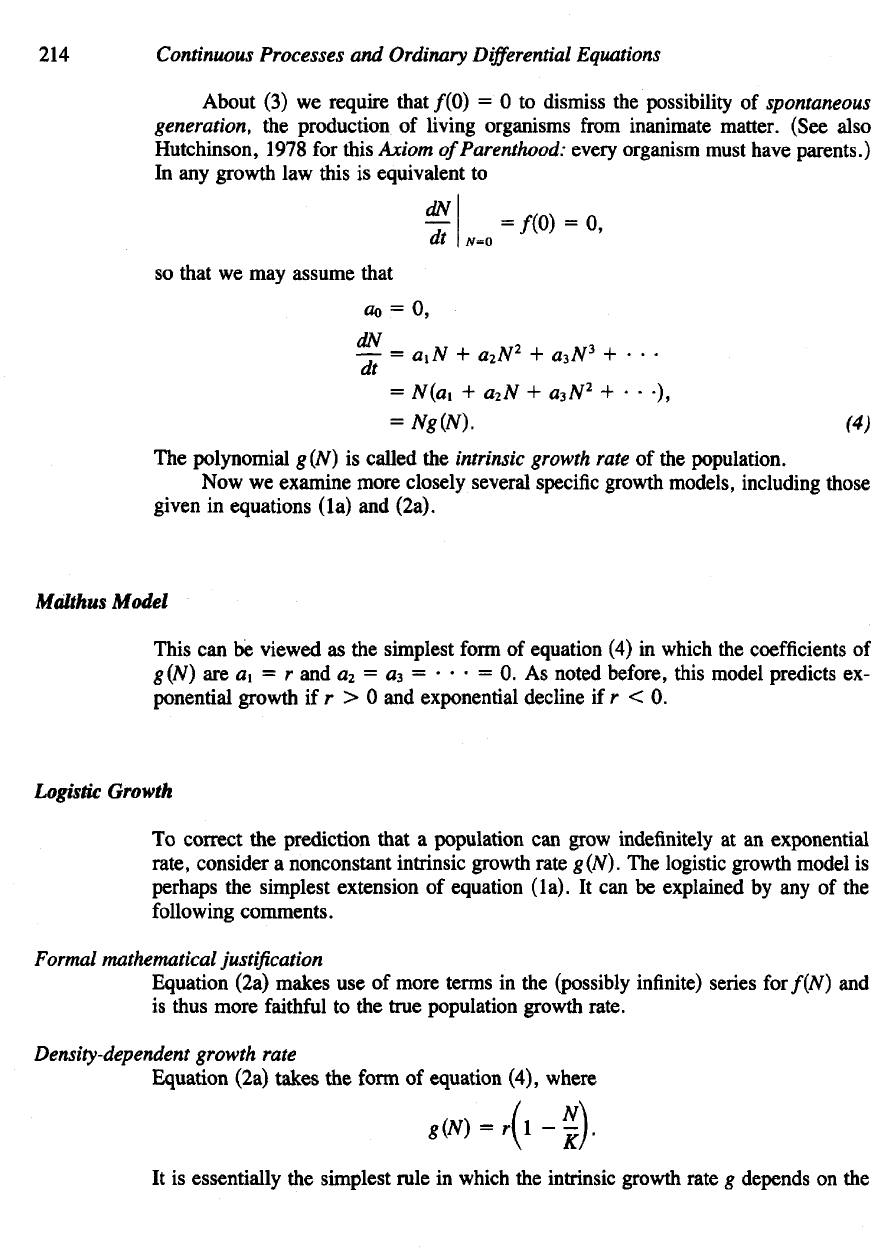
214
Continuous Processes
and
Ordinary
Differential
Equations
About
(3) we
require that /(O)
= 0 to
dismiss
the
possibility
of
spontaneous
generation,
the
production
of
living organisms
from
inanimate matter. (See also
Hutchinson, 1978
for
this Axiom
of
Parenthood: every organism must have parents.)
In
any
growth
law
this
is
equivalent
to
The
polynomial g(N)
is
called
the
intrinsic growth
rate
of the
population.
Now
we
examine more closely several
specific
growth models, including those
given
in
equations (la)
and
(2a).
Malthus
Model
This
can be
viewed
as the
simplest
form
of
equation
(4) in
which
the
coefficients
of
g(N)
are a\ — r and a
2
= 03 = • • • = 0. As
noted before, this model predicts
ex-
ponential growth
if r > 0 and
exponential decline
if r < 0.
Logistic
Growth
To
correct
the
prediction
that
a
population
can
grow indefinitely
at an
exponential
rate, consider
a
nonconstant intrinsic growth rate g(N).
The
logistic growth model
is
perhaps
the
simplest extension
of
equation (la).
It can be
explained
by any of the
following
comments.
Formal
mathematical
justification
Equation (2a) makes
use of
more terms
in the
(possibly
infinite)
series for/(AO
and
is
thus more
faithful
to the
true population growth rate.
Density-dependent
growth rate
Equation (2a)
takes
the
form
of
equation (4), where
so
that
we may
assume that
It
is
essentially
the
simplest rule
in
which
the
intrinsic growth rate
g
depends
on the
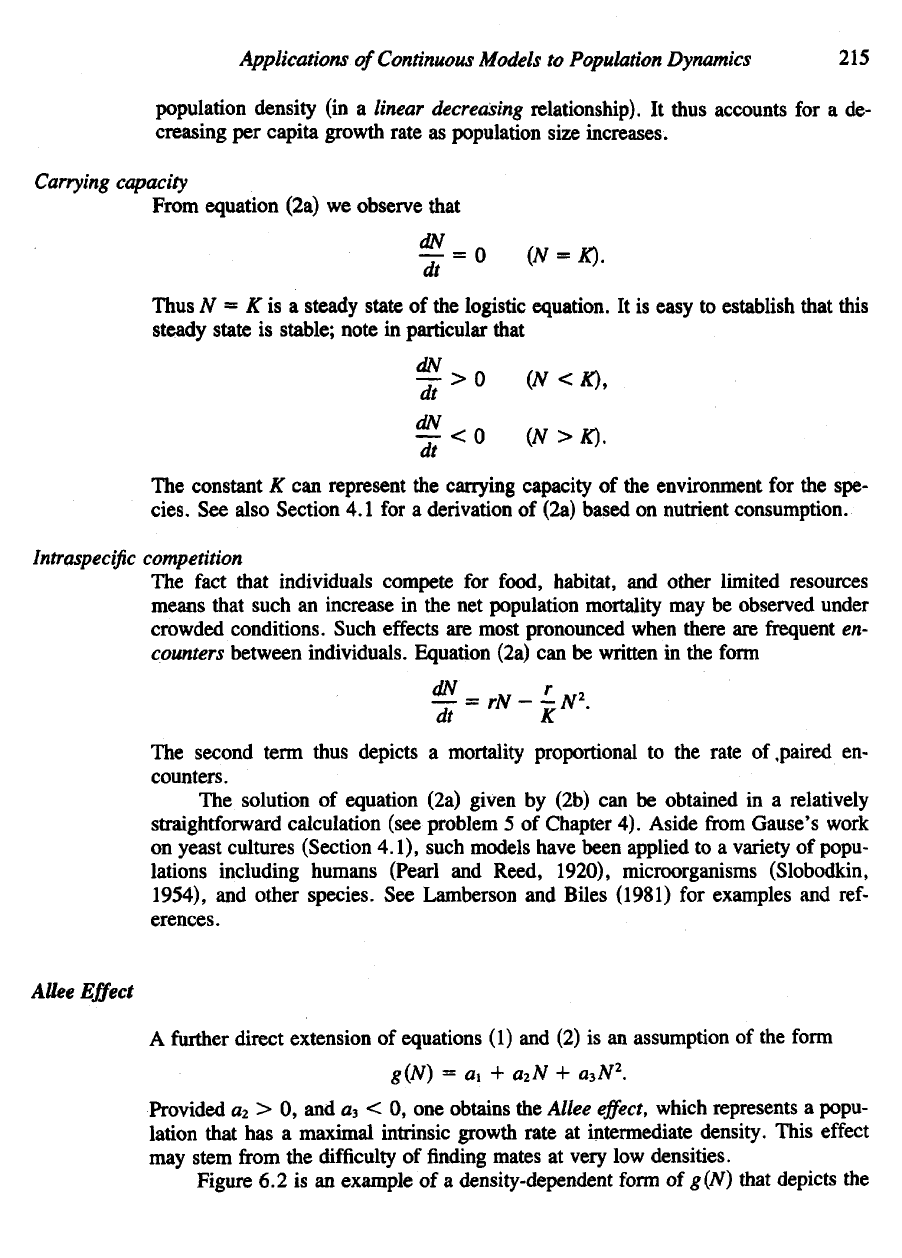
Applications
of
Continuous
Models
to
Population
Dynamics
215
population density
(in a
linear
decreasing
relationship).
It
thus accounts
for a de-
creasing
per
capita growth rate
as
population size increases.
Carrying
capacity
From equation (2a)
we
observe that
Thus
N = K is a
steady state
of the
logistic equation.
It is
easy
to
establish that this
steady state
is
stable; note
in
particular that
The
constant
K can
represent
the
carrying capacity
of the
environment
for the
spe-
cies.
See
also Section
4.1 for a
derivation
of
(2a) based
on
nutrient consumption.
Intraspecific
competition
The
fact that individuals compete
for
food, habitat,
and
other limited resources
means that such
an
increase
in the net
population mortality
may be
observed under
crowded conditions. Such
effects
are
most pronounced when there
are
frequent
en-
counters
between individuals. Equation (2a)
can be
written
in the
form
The
second term thus depicts
a
mortality proportional
to the
rate
of
.paired
en-
counters.
The
solution
of
equation (2a) given
by
(2b)
can be
obtained
in a
relatively
straightforward calculation (see problem
5 of
Chapter
4).
Aside
from
Cause's
work
on
yeast cultures (Section 4.1), such models have been applied
to a
variety
of
popu-
lations including humans (Pearl
and
Reed, 1920), microorganisms (Slobodkin,
1954),
and
other
species.
See
Lamberson
and
Biles
(1981)
for
examples
and
ref-
erences.
AUee
Effect
A
further
direct
extension
of
equations
(1) and (2) is an
assumption
of the
form
Provided
a*
> 0, and c
3
< 0, one
obtains
the
AUee
effect,
which represents
a
popu-
lation that
has a
maximal intrinsic growth rate
at
intermediate density. This
effect
may
stem
from the
difficulty
of
finding
mates
at
very
low
densities.
Figure
6.2 is an
example
of a
density-dependent
form
of
g(N) that
depicts
the
